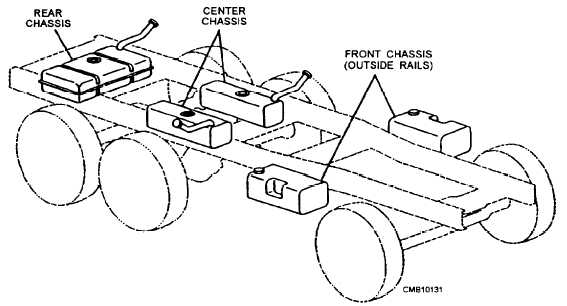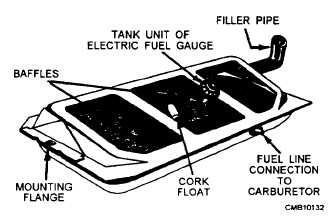FUEL LINES (carries fuel between the tank, the pump, and other parts)
Fuel Tank
An automotive fuel tank must safely hold an adequate supply of fuel for prolonged engine operation. The location of the fuel tank (fig. 4-2) should be in an area that is protected from flying debris, shielded from collision damage, and one that is not subject to bottoming. A fuel tank can be located just about anywhere in the vehicle that meets these requirements.
Figure 4-3 shows the general construction of a fuel tank used on automotive equipment. Fuel tanks are usually made of thin sheet metal or plastic. The main body of a metal tank is made by soldering or welding two formed pieces of sheet metal together. Other parts (filer neck, fuel tank cap, and baffles) are added to the form to complete the fuel tank assembly. A lead-tin alloy is normally plated to the sheet metal to prevent the tank from rusting.
The fuel tank filler neck is an extension on the tank for filling the tank with fuel. The filler cap fits on the end of the filler neck. The neck extends from the tank through the body of the vehicle. A flexible hose is normally used as part of the filler neck to allow for tank vibration without breakage.
In vehicles requiring unleaded fuel, a fuel neck restrictor is used inside the filler neck. This prevents the accidental use of leaded gasoline in an engine designed for unleaded. The restrictor is too small to accept the larger leaded fuel type pump nozzle.
WARNING
If the restrictor is removed and leaded fuel is used in a vehicle designed for unleaded fuel, the catalytic converter will be damaged. This action is a violation of federal law; therefore, NEVER remove the filler neck restrictor.
Modern fuel tank caps are sealed to prevent escape of fuel and fuel vapors (emissions) from the tank. The cap has pressure and vacuum valves that only open under abnormal conditions of high pressure or vacuum.

Figure 4-3. - Fuel tank with top cut away.

Figure 4-2. - Common fuel tank locations.
Continue Reading